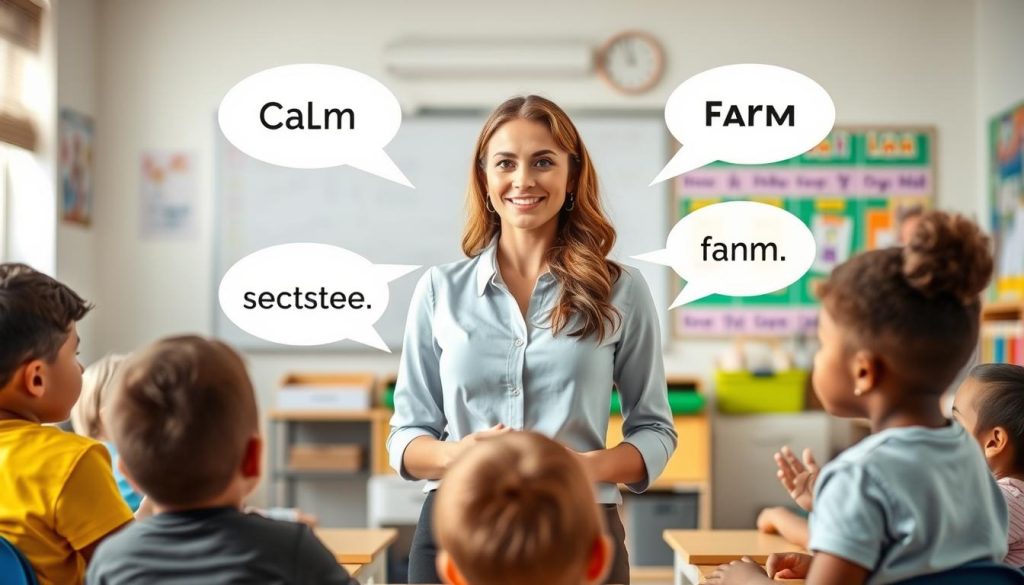Classroom Management Strategy #1: Harness the Power of Your Voice
Your tone of voice might be the most underrated classroom management tool in your arsenal. Research consistently shows that how you speak to students significantly impacts their perception of you, their willingness to engage, and the overall classroom culture. Developing this crucial teacher skill can transform challenging classroom dynamics almost immediately.
According to educational researchers, students use a teacher’s tone to determine whether they’re liked, respected, and believed in. This perception directly influences their participation and engagement with challenging material. Your voice communicates far more than your words alone—it reveals your expectations, patience level, and authentic interest in student contributions.
Different Tones for Different Classroom Moments
The Enthusiastic Tone: When introducing new concepts or activities, an enthusiastic tone signals to students that the material is worth their attention. Research links teacher enthusiasm directly to student motivation. The key is authenticity—students quickly detect forced excitement.
The Calm, Measured Tone: During transitions, conflict resolution, or when introducing complex concepts, a calm tone creates safety and stability. This approach models emotional regulation for your students—an essential teacher skill that contributes to positive classroom management.
The Firm, Clear Tone: When establishing procedures or addressing behavioral issues, a firm tone communicates boundaries without aggression. This balance is among the most valuable teacher skills for effective discipline.
The Warm, Supportive Tone: When providing feedback or checking in with struggling students, a warm tone creates psychological safety—a critical component of positive classroom culture that enables students to take risks and engage deeply with learning.
Developing awareness of these tone patterns is an essential teacher skill that directly impacts your classroom management. If you’re unsure about your tone patterns, consider recording a lesson and listening for these tendencies. You might be surprised by what you hear.
Master the Art of Vocal Communication
Discover how your tone of voice shapes classroom culture and student engagement with our in-depth guide.
Classroom Management Strategy #2: Implement Effective Noise Control

Every teacher has experienced that moment when classroom noise reaches a fever pitch. Managing noise levels effectively is a fundamental teacher skill that can make or break your lesson flow. The key is distinguishing between productive academic noise and disruptive chatter.
Preventative Noise Management Strategies
Establish Clear Expectations: Create visual noise level charts that indicate appropriate volume for various activities. This fundamental teacher skill helps students self-regulate their behavior and understand what “quiet work time” actually sounds like.
Design Strategic Seating: Thoughtful seating arrangements can significantly reduce noise issues. Consider separating chatty students and creating zones for different activities to contain sound within specific areas.
Implement Transition Routines: Transitions between activities are prime times for noise escalation. Develop consistent routines and signals for transitions to minimize disruption. This teacher skill creates predictability that helps students stay focused.
Create a Calm Physical Environment: Your classroom’s physical setup influences noise levels. Consider acoustic-friendly materials, strategic furniture arrangement, and designated quiet zones to create a more sound-controlled environment.
Immediate Interventions for Noisy Classrooms
Attention Signals: Develop a consistent attention signal that cuts through noise without adding to it. Options include chimes, clapping patterns, or raised hand signals.
Voice Modulation: Counterintuitively, lowering your voice rather than raising it can be more effective. When you speak quietly, students often quiet down to hear what you’re saying.
Strategic Silence: Sometimes the most powerful tool is silence. Stop teaching and wait quietly until students notice and quiet themselves. This technique leverages peer pressure positively.
Implementing these noise management strategies consistently is key to their effectiveness. Start by selecting 2-3 tools that address your specific classroom challenges, introduce them one at a time, and reinforce them consistently. Remember that developing effective teacher skills for noise management takes time and patience.
Transform Your Classroom Soundscape
Discover 20 proven tools and techniques to create a focused, productive learning environment.
Classroom Management Strategy #3: Integrate Emotional Regulation with Discipline
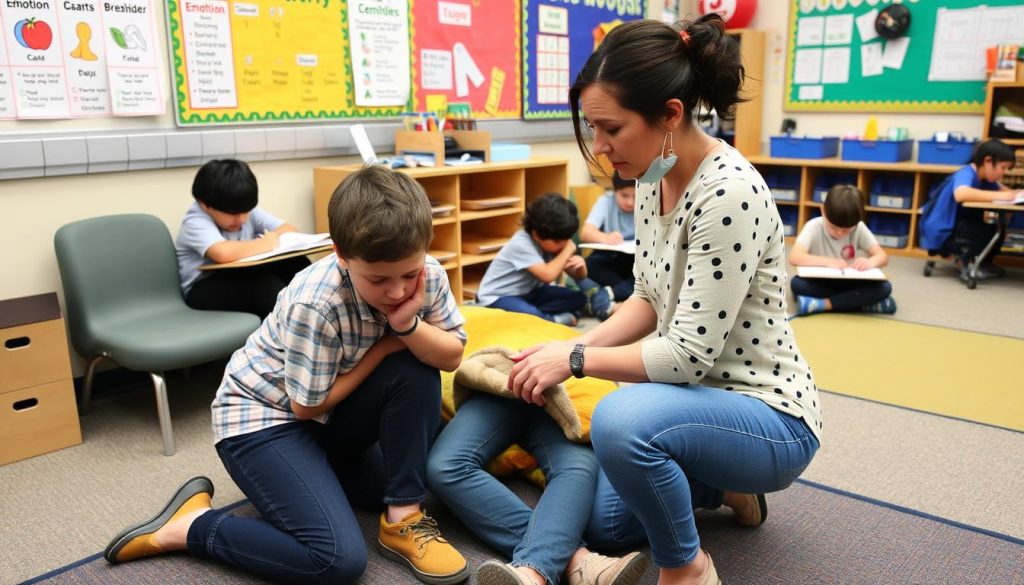
Traditional classroom management often focuses solely on controlling behavior through rewards and consequences. While these approaches can be effective in the short term, they miss a crucial element: the emotional foundations of behavior. Students who act out are frequently struggling with emotions they don’t understand or can’t control.
Emotional regulation refers to our ability to manage our emotional responses in healthy ways. For students, this skill is still developing, and many disruptive behaviors stem from underdeveloped regulation abilities. When we incorporate emotional regulation into our discipline approach, we address both the immediate behavior and the underlying emotional needs.
The Emotional Brain in the Classroom
When a student feels threatened, anxious, or overwhelmed, their amygdala (the brain’s alarm system) activates, triggering a fight, flight, or freeze response. In the classroom, this might look like arguing back (fight), running out of the room (flight), or shutting down (freeze). Traditional discipline that focuses only on the behavior without addressing the emotional state can actually intensify these reactions.
Practical Emotional Regulation Strategies
- Create a designated “calm-down corner” with sensory tools and visual reminders of calming strategies
- Teach students to identify and name their emotions using emotion charts and vocabulary building
- Model co-regulation by using a calm voice and validating feelings while setting boundaries
- Implement the “regulate-relate-reason” approach: help students calm down before addressing behavior
- Develop tiered support for emotional regulation based on individual student needs
Teacher Emotional Regulation
Perhaps the most overlooked aspect of classroom management is the teacher’s own emotional regulation. Students learn more from what we model than from what we say, making our self-regulation crucial to an effective emotional approach to discipline.
Develop your own regulation toolkit with these practices:
- Identify your emotional triggers in the classroom
- Practice quick reset techniques (deep breathing, grounding)
- Use positive self-talk during challenging moments
- Take brief breaks when possible (even 30 seconds helps)
- Develop supportive connections with colleagues
Integrating emotional regulation into your classroom management approach represents a significant shift from traditional behavior management. Rather than simply controlling student behavior, this approach develops essential life skills while creating a more positive, productive learning environment. This advanced teacher skill can transform your classroom culture and reduce discipline issues over time.
Transform Your Approach to Classroom Discipline
Learn how to combine emotional regulation with effective discipline strategies for lasting behavioral change.
Classroom Management Strategy #4: Avoid Common Management Mistakes
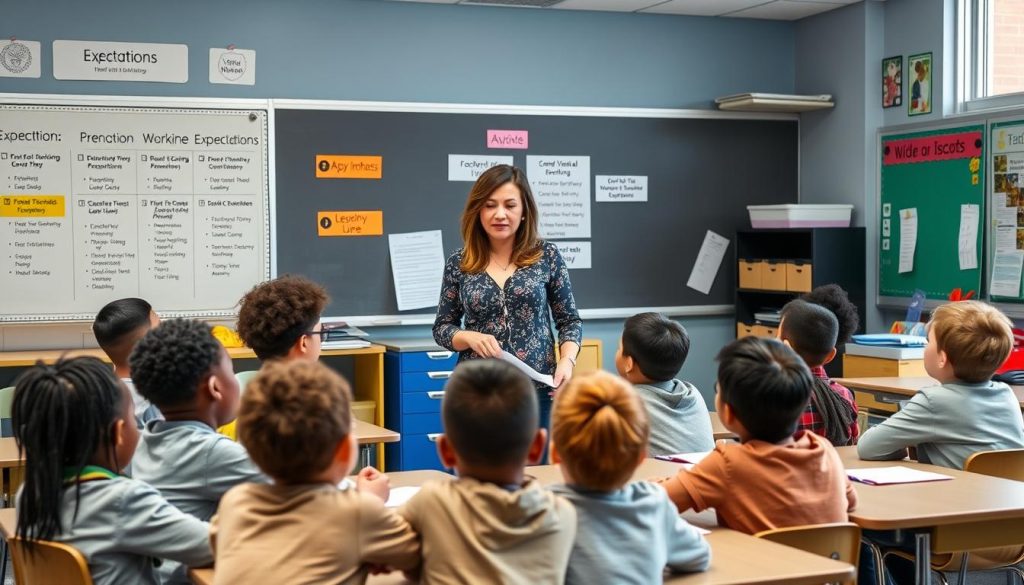
Even experienced educators can fall into common classroom management traps. Recognizing and avoiding these pitfalls is a crucial teacher skill that can dramatically improve your classroom environment. By understanding what not to do, you can refine your approach and develop more effective strategies.
Common Classroom Management Mistakes
- Inconsistent Expectations: Changing rules or consequences unpredictably creates confusion and undermines your authority
- Negative Framing: Focusing on what students shouldn’t do rather than what they should do
- Addressing the Group for Individual Issues: Punishing the entire class for the actions of a few students damages rapport
- Reactive Rather Than Proactive Management: Waiting for problems to occur instead of preventing them
Effective Alternatives
- Establish Clear, Consistent Expectations: Create and maintain predictable rules and consequences
- Use Positive Framing: Tell students what to do rather than what not to do
- Address Individual Behavior Privately: Speak directly with students who need correction
- Implement Preventative Strategies: Anticipate potential issues and plan accordingly
Developing these teacher skills takes practice and reflection. Consider keeping a classroom management journal to track what works and what doesn’t in your specific context. This reflective practice can help you identify patterns and refine your approach over time.
“The most effective classroom managers aren’t those who respond perfectly to problems; they’re those who prevent problems from occurring in the first place.”
By avoiding these common mistakes and implementing their alternatives, you’ll create a more positive, productive learning environment where students understand expectations and feel supported in meeting them. This proactive approach to classroom management is a hallmark of effective teaching.
Refine Your Classroom Management Approach
Learn how to identify and correct the most common classroom management mistakes with our comprehensive guide.
Classroom Management Strategy #5: Establish Effective Technology Policies
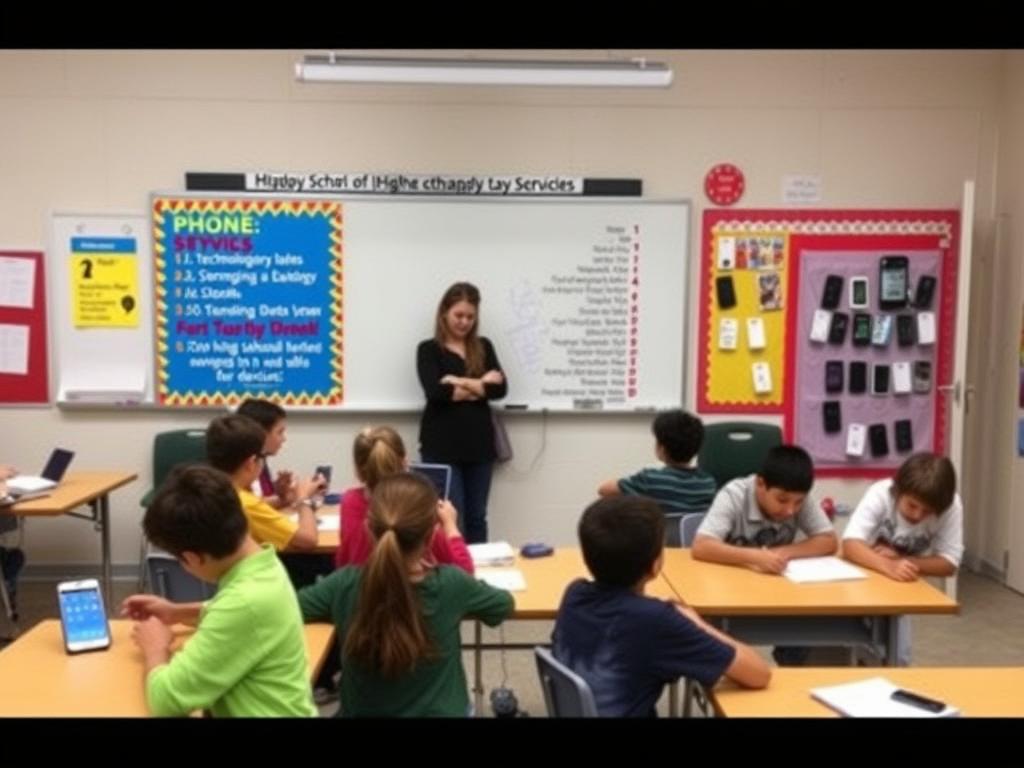
In today’s digital world, managing technology—particularly smartphones—has become a critical classroom management challenge. Finding the right balance between leveraging technology’s benefits and preventing distractions requires thoughtful policies and consistent implementation.
Creating Effective Phone Policies
Clear Expectations
Establish explicit rules for when and how phones can be used in your classroom. Consider different policies for various activities:
- Research and educational activities
- Transition times
- Independent work
- Direct instruction
- Group discussions
Physical Management Systems
Create physical systems for storing phones during restricted times:
- Numbered pocket charts
- Phone “parking lots” on desks
- Charging stations away from work areas
- Locked storage for high-stakes testing
Implementation Strategies
The most effective phone management approaches combine clear policies with consistent implementation. Consider these teacher skills for technology management:
Involve Students: Get student input when creating technology policies to increase buy-in and compliance.
Teach Digital Citizenship: Help students understand appropriate technology use as part of your classroom management approach.
Model Appropriate Use: Demonstrate proper technology etiquette by managing your own phone use during class time.
Remember that effective technology management is about teaching students to self-regulate their digital habits—a crucial life skill in today’s world. By establishing clear expectations and consistent consequences, you help students develop responsible technology use while maintaining a focused learning environment.
Master Technology Management in Your Classroom
Discover research-backed strategies for creating effective phone policies that minimize distractions and maximize learning.
Classroom Management Strategy #6: De-escalate a Rowdy Classroom
Even with the best preventative classroom management strategies, there will be times when student energy escalates beyond productive levels. Having effective de-escalation techniques in your teacher skills toolkit is essential for quickly returning to a focused learning environment.
Immediate Interventions for a Rowdy Classroom
Pattern Interrupts
Sometimes the most effective way to calm a rowdy classroom is to break the current pattern of behavior:
- Use an unexpected sound (chime, rain stick, or unique clapping pattern)
- Switch to a whisper voice suddenly
- Stand in a different location than usual
- Use a visual timer to create urgency
- Implement a quick physical movement break
Reset Activities
These structured activities can help students transition from high energy to focused attention:
- Guided breathing exercises (30-60 seconds)
- Quick mindfulness moment
- Progressive muscle relaxation
- Structured brain breaks
- Transition songs or chants
The key to effectively calming a rowdy classroom is responding early, before behavior escalates beyond control. Developing the teacher skill of recognizing early warning signs—increased volume, faster movements, off-task conversations—allows you to intervene at the optimal moment.
Pro Tip: When using de-escalation strategies, maintain a calm, confident demeanor. Your emotional state is contagious—if you appear anxious or frustrated, students will mirror that energy. Practice projecting calm authority even when you feel challenged.
Remember that high energy isn’t always negative. Sometimes students need appropriate outlets for their energy before they can focus on learning. Building regular movement and expression opportunities into your lessons can prevent the buildup that leads to disruptive behavior.
Master the Art of Classroom De-escalation
Discover six proven strategies for quickly calming a rowdy classroom and returning to productive learning.
Classroom Management Strategy #7: Build a Strong Classroom Community
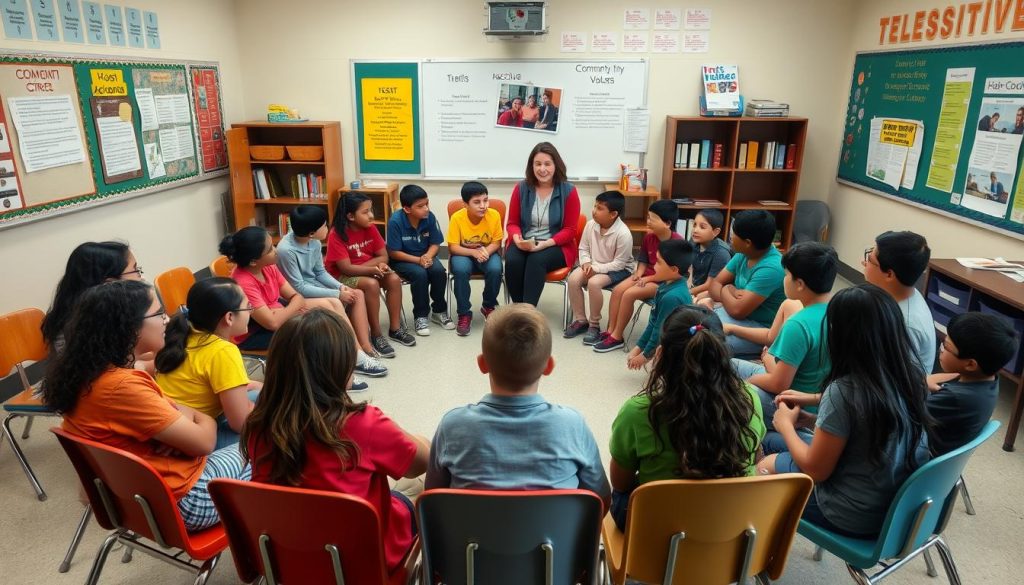
A strong classroom community forms the foundation for effective classroom management. When students feel connected to their peers and teacher, they’re more motivated to follow expectations and contribute positively to the learning environment. Building this sense of community is a fundamental teacher skill that pays dividends throughout the school year.
Essential Community-Building Strategies
Morning Meetings
Regular community gatherings create connection and set a positive tone. Include:
- Greeting rituals
- Sharing opportunities
- Group activities
- Morning message
Collaborative Agreements
Co-create classroom expectations with students:
- Focus on values, not just rules
- Use positive language
- Revisit and revise regularly
- Connect to real classroom scenarios
Celebration Rituals
Acknowledge both academic and social growth:
- Recognition circles
- Appreciation notes
- Progress celebrations
- Community accomplishment tracking
Building community isn’t a one-time activity but an ongoing process that requires intentional effort. The investment in these teacher skills creates a classroom where students feel safe taking academic risks and are more likely to regulate their behavior to maintain positive relationships.
“The stronger the relationships and sense of community in your classroom, the fewer behavior problems you’ll need to address. Community building isn’t separate from classroom management—it’s the foundation.”
Research consistently shows that students who feel a sense of belonging in their classroom demonstrate better academic performance, higher engagement, and fewer behavioral issues. By prioritizing community building as a core classroom management strategy, you create the conditions for both academic and social-emotional success.
Create a Thriving Classroom Community
Discover eight powerful community-building strategies that transform classroom culture and improve behavior.
Classroom Management Strategy #8: Support English Language Learners
Effective classroom management must address the diverse needs of all learners, including English Language Learners (ELLs). When ELL students understand expectations and can fully participate in classroom activities, behavior issues decrease and engagement increases. Developing specialized teacher skills for supporting ELLs is essential in today’s diverse classrooms.
Essential Supports for English Language Learners
Clear Communication Strategies
- Use visual supports alongside verbal instructions
- Implement consistent classroom routines with visual schedules
- Provide written directions for multi-step tasks
- Use gestures and demonstrations to clarify meaning
- Speak clearly at a moderate pace without oversimplifying language
Culturally Responsive Management
- Learn about students’ cultural backgrounds and communication norms
- Recognize that behavior expectations may differ across cultures
- Create opportunities for students to share their cultural knowledge
- Ensure classroom management approaches respect cultural differences
- Build relationships with families to better understand home expectations
Supporting ELL students requires specialized teacher skills that go beyond general classroom management strategies. By implementing these approaches, you create an inclusive environment where all students can thrive, regardless of their language background.
Remember: Language acquisition takes time. ELL students may understand classroom expectations but still be developing the language skills to fully participate. Patience, scaffolding, and multiple modes of expression are key to supporting their success.
When ELL students feel supported and understood, they’re more likely to engage positively with classroom activities and follow established expectations. This inclusive approach to classroom management benefits all students by creating a culture of respect and accommodation for diverse needs.
Support Your English Language Learners
Discover eight vital tools and strategies for creating an inclusive, supportive environment for ELL students.
Bringing It All Together: Your Classroom Management Transformation
Effective classroom management isn’t about controlling students—it’s about creating an environment where learning can flourish. By implementing these eight strategies, you’re developing essential teacher skills that will serve you and your students throughout your career. Remember that classroom management is both an art and a science, requiring ongoing reflection, adaptation, and growth.
The most successful classroom managers integrate multiple strategies, adapting their approach to meet the specific needs of their students and teaching context. Start by selecting one or two strategies that address your most pressing classroom management challenges, implement them consistently, and then gradually incorporate additional approaches as you build your confidence and skill.
“The quality of a school as a learning community can be measured by how it treats its most vulnerable members—and by how well all students are learning and thriving.”
As you refine your classroom management approach, remember that the ultimate goal is creating a positive, inclusive learning environment where all students feel valued, supported, and empowered to succeed. The teacher skills you develop through this process will not only improve your classroom experience but will also equip your students with valuable self-regulation and social skills they’ll carry beyond your classroom.
We invite you to continue your professional growth journey by exploring the comprehensive resources available through Credits for Teachers. Our research-based courses provide in-depth strategies for enhancing your teaching practice and earning valuable professional development credit.
Transform Your Classroom Management Approach
Discover our comprehensive Effective Discipline course with proven strategies for creating a positive, productive learning environment.

